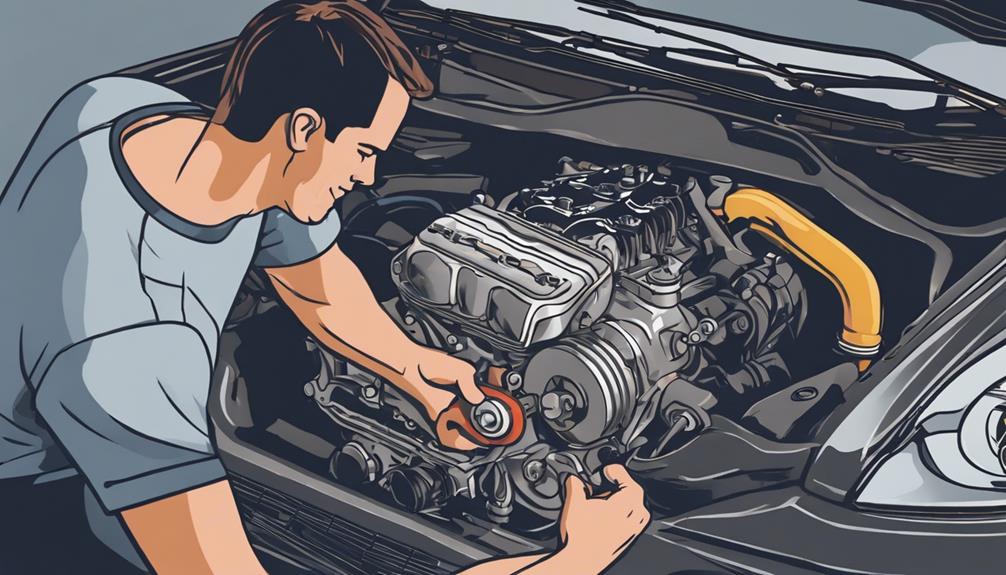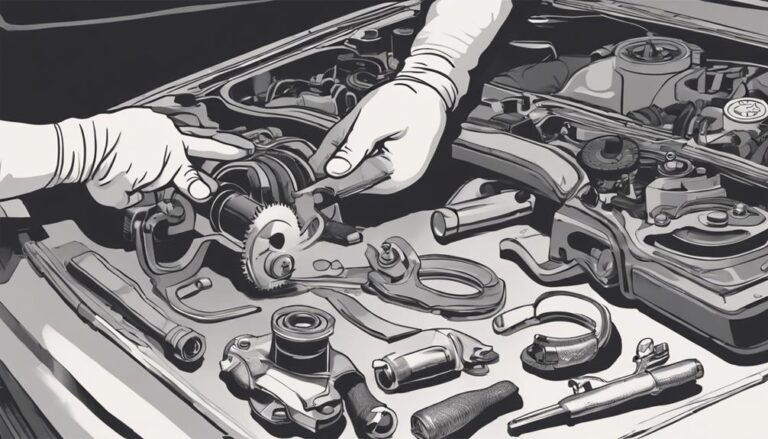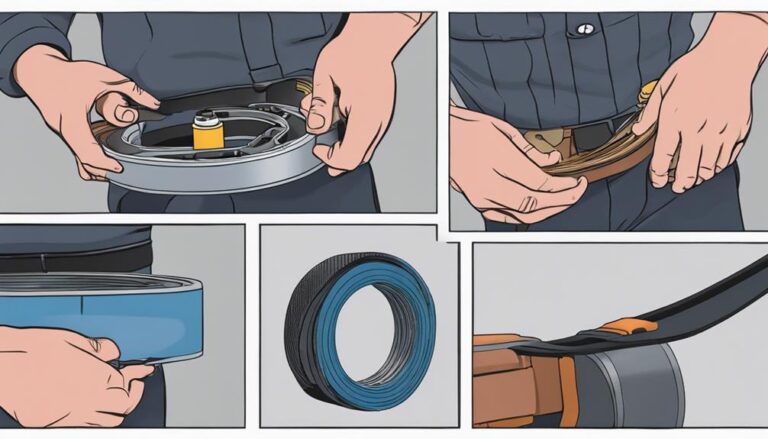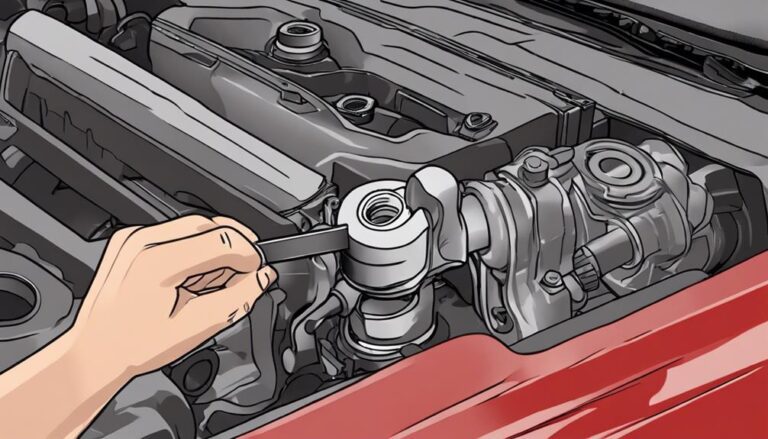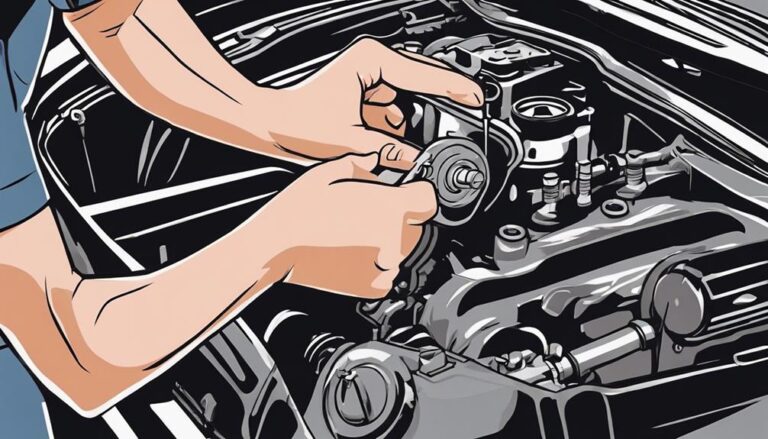Maintaining Optimal Engine Performance: Loose Drive Belt Solutions
Have you ever experienced the unsettling sound of a loose drive belt in your vehicle, causing an unwelcome disruption to your engine's performance?
The consequences of neglecting this crucial component can be more significant than you might imagine.
As you navigate the intricacies of maintaining top-notch engine function, understanding the signs of a loose drive belt and exploring effective solutions becomes paramount.
Stay tuned to discover practical tips to address this common issue and safeguard your engine's longevity and efficiency.
Key Takeaways
- Regularly check for signs of a loose drive belt to prevent engine damage.
- Address squealing noises or visible wear promptly to maintain engine efficiency.
- Ensure proper tension for optimal power transmission and component operation.
- Prioritize drive belt maintenance to enhance engine longevity and prevent breakdowns.
Impact of Loose Drive Belt on Engine

When a drive belt becomes loose, it can greatly diminish engine performance and lead to potential mechanical failures. Drive belt tension is critical for best engine efficiency. The drive belt is responsible for transferring power from the engine to various components like the alternator, water pump, power steering pump, and air conditioning compressor. If the belt is loose, it can slip or even come off entirely, causing these components to function inadequately or not at all.
Maintaining proper drive belt tension is a fundamental aspect of engine maintenance. A loose belt won't only reduce the performance of these critical systems but can also put a strain on the engine itself. When components like the water pump or alternator fail to operate correctly due to a loose belt, it can lead to overheating, battery drainage, or other serious mechanical issues.
To ensure best engine efficiency and prevent potential failures, regular inspection of drive belt tension is essential. Proper maintenance of this component won't only enhance engine performance but also prolong the lifespan of your vehicle.
Signs of a Loose Drive Belt
Detecting a loose drive belt can be important for maintaining top engine performance. One of the key signs to look out for is drive belt tension. A loose belt may appear visibly slack or worn, which can affect its ability to grip the pulleys effectively. This lack of tension can lead to slipping, causing various engine components to work improperly or not at all.
Additionally, you may hear squealing noises coming from the engine area, especially when you accelerate or turn on the air conditioning. These sounds indicate that the belt is slipping due to insufficient tension. Another indicator is the presence of visible cracks or fraying on the belt surface, which may signal the need for belt replacement.
Potential Engine Damage From a Loose Belt

Inspecting a loose drive belt for signs of wear and tension is important to prevent potential engine damage. When a drive belt becomes loose, it can lead to various issues that may harm your engine in the long run. Here are some key points to take into account:
- Preventing Wear: A loose belt can cause excessive friction and wear on the pulleys and other components it interacts with. This wear can lead to premature failure of these parts, resulting in costly repairs and downtime for your vehicle.
- Minimizing Noise: Loose belts often produce squealing or chirping noises due to slippage. Ignoring these noises can indicate a loose belt is causing unnecessary strain on the engine, potentially leading to more severe damage if left unaddressed.
- Maintaining Efficiency: A loose belt can cause the engine to work harder to operate various components, decreasing overall efficiency and performance. By ensuring proper tension, you can help your engine operate smoothly and maintain peak performance levels.
Regularly checking and adjusting the tension of your drive belt can help prevent these issues and keep your engine running smoothly while minimizing wear and noise.
Importance of Drive Belt Tension
Ensuring proper tension in your drive belt is essential for top engine performance and longevity. Drive belt tension refers to the force that keeps the belt properly aligned and in place within the engine. When the tension is correct, it allows for best power transmission from the engine to various components such as the alternator, water pump, and air conditioning compressor. This, in turn, guarantees that these parts operate efficiently, maximizing overall performance efficiency.
Incorrect tension can lead to slippage, causing wear and tear on the belt and other engine components. If the belt is too loose, it may not rotate the pulleys effectively, resulting in decreased power output and efficiency. On the other hand, if the belt is too tight, it can put excessive strain on the engine and accessories, leading to premature wear and potential damage.
Regularly checking and adjusting the drive belt tension as part of your maintenance routine will help maintain best engine performance and extend the lifespan of your vehicle's components.
Benefits of Regular Drive Belt Maintenance

Regularly maintaining your drive belt can greatly enhance engine performance and extend the lifespan of your vehicle's components. By taking preventative measures and ensuring the drive belt is in ideal condition, you can reap the following benefits:
- Preventative Measures: Regular inspections and adjustments of the drive belt tension can help identify issues before they escalate, preventing sudden breakdowns or costly repairs.
- Longevity Benefits: Proper maintenance of the drive belt reduces wear and tear on other engine components, such as the alternator and water pump, leading to increased longevity of these parts.
- Efficiency Improvement: A well-maintained drive belt results in smoother operation of engine accessories, improving overall efficiency and performance of your vehicle.
Frequently Asked Questions
Can a Loose Drive Belt Cause Damage to Other Engine Components Besides the Belt Itself?
If your drive belt is loose, it can cause potential damage to other engine components, not just the belt itself. Regular maintenance and inspections can help prevent these issues, ensuring peak engine performance and longevity.
How Often Should Drive Belt Tension Be Checked and Adjusted to Ensure Optimal Engine Performance?
To guarantee top engine performance, it's critical to regularly check and adjust drive belt tension. DIY maintenance techniques can help. Frequency of inspections depends on driving conditions, but a general recommendation is every 12,000-15,000 miles.
Are There Any DIY Methods for Tightening a Loose Drive Belt, or Should It Always Be Done by a Professional Mechanic?
When it comes to tightening a loose drive belt, DIY methods can work if you have the right tools and expertise. Quick fixes like adjusting tension can be done at home, but for complex issues, trust a professional mechanic.
What Are Some Common Causes of Drive Belts Becoming Loose, and How Can They Be Prevented?
To prevent drive belts from becoming loose, focus on proper installation and consistent preventative maintenance. This approach will enhance belt longevity and overall engine performance. By adhering to these practices, you can avoid common causes of drive belt issues.
Are There Specific Types of Drive Belts That Are More Prone to Becoming Loose, and Are There Alternatives That May Offer Better Performance?
When it comes to drive belts, certain types might be more prone to loosening. Exploring performance alternatives could offer better reliability and efficiency. Consider different belt materials and designs to optimize your engine's power transmission.
Conclusion
To sum up, ignoring a loose drive belt is like playing Russian roulette with your engine. The potential damage that can result from a simple oversight can be catastrophic.
Regular maintenance and tension checks are essential in ensuring top-notch engine performance and avoiding costly repairs down the road. Don't underestimate the importance of this seemingly small component – it's the lifeline of your engine.

